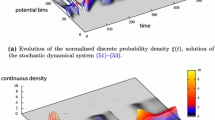Abstract
A statistical theory of an excitable membrane is proposed under the assumptions that the membrane is composed of an ensemble of a number of active patches, and that the flip-flop transition of an active patch is governed by the dissipative interaction caused by an electric eddy current. By the method of expanding the master equation in the system size together with the Gaussian approximation, the time course of an excitation and the steady N-shaped relation between current and voltage are derived from the ensemble theory of open systems. The fluctuation of electric current under a fixed voltage becomes anomalously large in the marginal state at the threshold potential. The fluctuation associated with an action potential increases sharply at the jump-up transition, but it is not so large at the flip-back catastrophe. The fluctuation-dissipation relation at the steady state of the membrane system is discussed on the basis of a variational principle.
Similar content being viewed by others
References
I. Tasaki,Nerve Excitation, Thomas, Springfield, Illinois (1968).
J. P. Changeux, J. Thiery, Y. Tung, and C. Kittel,Proc. Natl. Acad. Sci. U.S. 57:335 (1967); T. L. Hill,Proc. Natl. Acad. Sci. U.S. 58:111 (1967); R. Blumenthal, H. P. Changeux, and R. Lefever,Comp. Rend. 270:389 (1970).
I. Inoue, Y. Kobatake, and I. Tasaki,Biophys. Chem. 2:116 (1974); H. Gainer, E. Carbone, I. Singer, K. Sisco, and I. Tasaki,Comp. Biochem. Physiol. 46A:259, (1973); I. Inoue, N. Ishida, and Y. Kobatake,Biochim. Biophys. Acta 367:24 (1974); T. Ueda, M. Muratsugu, and Y. Kobatake,Biochim. Biophys. Acta 373:286 (1974).
Y. Aizawa and Y. Kobatake,Prog. Theor. Phys. 52:1094 (1974).
Y. Aizawa, Y. Shimatani, and Y. Kobatake,Prog. Theor. Phys. 53:305 (1975).
N. G. van Kampen,Can. J. Phys. 39:551 (1961); inFluctuation Phenomena in Solids, R. E. Burgess, ed., Academic Press, New York (1965); R. Kubo, K. Matsuo, and K. Kitahara,J. Stat. Phys. 9:51 (1973).
M. Suzuki and R. Kubo,J. Phys. Soc. Japan 24:51 (1968); G. S. Agarwal,Z. Physik. 252:25 (1972).
R. Graham,Springer Tracts in Modern Physics, Vol. 66, Springer, New York (1973).
Author information
Authors and Affiliations
Additional information
This study was supported partly by a grant from the Ministry of Education, Japan.
Rights and permissions
About this article
Cite this article
Aizawa, Y., Kobatake, Y. A statistical theory of excitable membranes. Nonlinear force-flux relation and fluctuation. J Stat Phys 15, 129–139 (1976). https://doi.org/10.1007/BF01012032
Received:
Issue Date:
DOI: https://doi.org/10.1007/BF01012032




